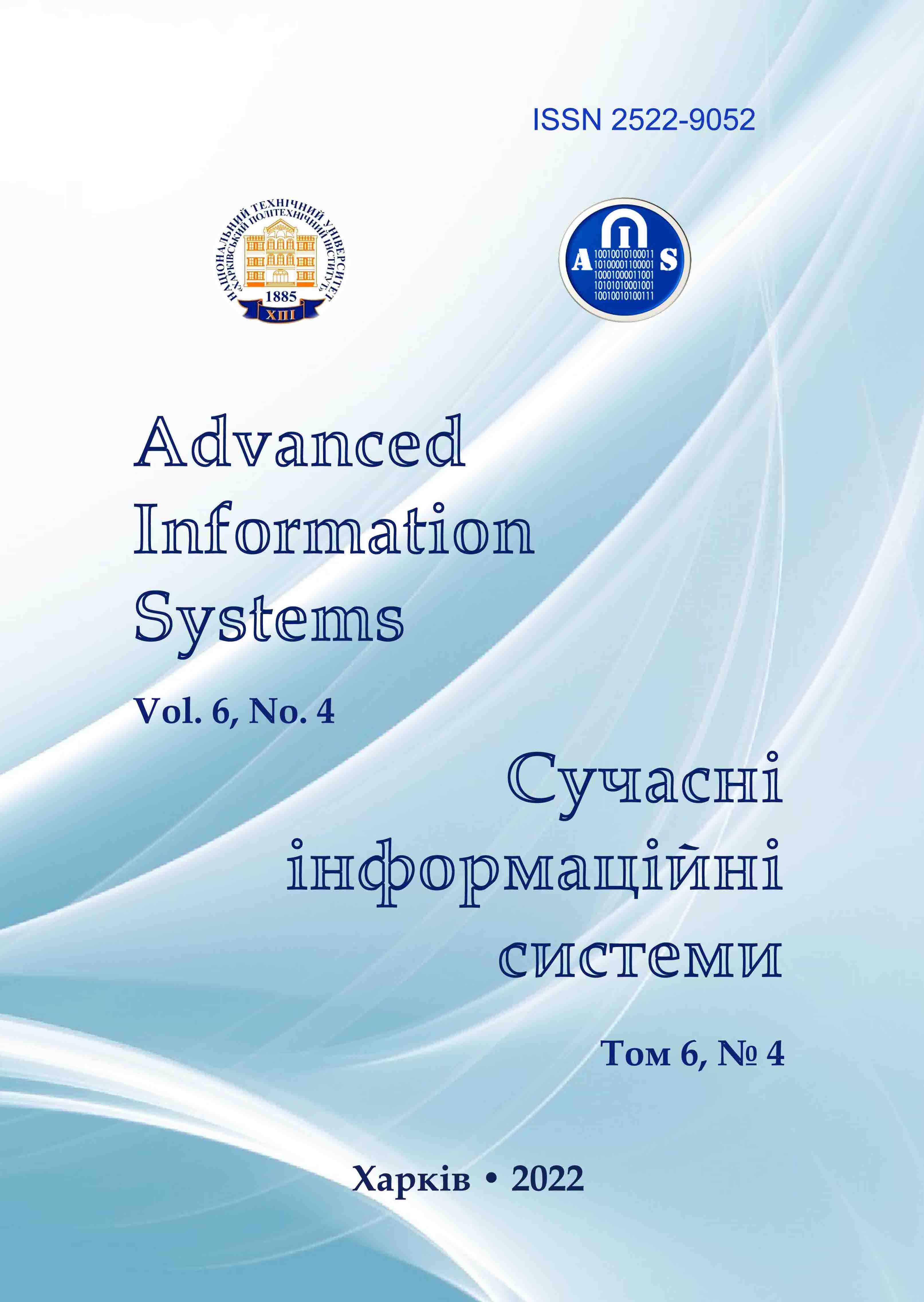DIAGNOSIS METHODS FOR MECHANISMS AND MACHINES BASED ON EMPIRICAL MODE DECOMPOSITION OF A VIBROSIGNAL AND THE WILCOXON TEST
Main Article Content
Abstract
Methods for diagnosing mechanisms and machines based on the analysis of vibration signals are considered. In particular, the comparison of various algorithms for analyzing vibration signals in the time and frequency domains was made, methods for selecting diagnostic features and methods for secondary processing were analyzed. The purpose of the study is to develop algorithms for selecting the vibration signal envelope based on empirical mode decomposition and decomposition of the signal into intrinsic mode functions, algorithms for the spectral estimation of envelopes and to choose a criterion for making a decision on object classification. It is proposed to choose the non-parametric Wilcoxon signed-rank test to determine the statistical significance of the difference between the parameters of normal and faulty objects. The multichannel microcontroller system for collecting data from an accelerometer and transmitting it to a computer via a local Wi-Fi network, including a number of independent data gathering nodes connected to a common distributed computing system, has been developed and experimentally studied. The computer processing of the recorded vibration signals for serviceable and faulty mechanisms was performed, including data decoding, Hilbert-Huang transform, spectral analysis using the Welch and Yule-Walker methods, and the choice of a diagnostic feature that provides maximum reliability of recognition. Based on the results of the work, it was determined that the empirical mode decomposition makes it possible to obtain vibration signal envelopes suitable for further diagnostics. Recommendations are developed for choosing the intrinsic mode function and the spectral analysis algorithm, it is determined that the first intrinsic mode function is the most informative for the mechanism under study. In accordance with the Wilcoxon criterion, the degree of diagnostic reliability was numerically determined in the analysis of the spectral power density of the vibration signal and the amplitude of peaks, and the comparison of probabilities of error-free recognition for various modifications of the algorithm was made.
Article Details
References
Henriquez, P., Alonso, J. B., Ferrer, M. A. and Travieso, C. M. (2014), “Review of Automatic Fault Diagnosis Systems Using Audio and Vibration Signals”, IEEE Transactions on Systems, Man, and Cybernetics, Vol. 44, Issue 5, pp. 542–652, doi: https://doi.org/10.1109/TSMCC.2013.2257752.
Shunming, Li, Yu, Xin, Xianglian, Li, Jinrui, Wang and Kun, Xu (2019), “A Review on the Signal Processing Methods of Rotating Machinery Fault Diagnosis”, 2019 IEEE 8th Joint International Information Technology and Artificial Intelligence Conference (ITAIC 2019), pp. 1559–1565, doi: https://doi.org/10.1109/ITAIC.2019.8785572.
Boudiaf, A., Djebala, A., Bendjma, H., Balaska, A. and Dahane.A. (2016), “A summary of vibration analysis techniques for fault detection and diagnosis in bearing”. 2016 8th International Conference on Modelling, Identification and Control (ICMIC), pp. 37–42, doi: https://doi.org/10.1109/ICMIC.2016.7804187.
Ge, Xin, Zhe, Li, Limin, Jia and Qitian, Zhong (2022), “Fault Diagnosis of Wheelset Bearings in High-Speed Trains Using Logarithmic Short-Time Fourier Transform and Modified Self-Calibrated Residual Network”, IEEE Transactions on Industrial Informatics, Vol. 18, Issue 10, pp. 7285–7295, doi: https://doi.org/10.1109/TII.2021.3136144.
Wei, Xi, Lin, Bai, Meng, Hui and Qisheng Wu (2018), “A Novel Rolling Bearing Fault Diagnosis Method Based on Empirical Wavelet Transform and Spectral Trend”, 2018 13th IEEE Conference on Industrial Electronics and Applications (ICIEA), pp. 2764-2768, doi: https://doi.org/10.1109/ICIEA.2018.8398179.
Cheng, Yang; Zhinong, Li; Jin, Yuan and Xiqin, Zhang (2017), “Fractional-order smoothed pseudo wigner-ville distribution and its applications in machinery fault diagnosis”, 2017 Prognostics and System Health Management Conference (PHM-Harbin), doi: https://doi.org/10.1109/PHM.2017.8079262.
Hui, L. (2010), “Bi-spectrum analysis based bearing fault diagnosis”, 2010 Seventh International Conference on Fuzzy Systems and Knowledge Discovery (FSKD 2010), pp. 2599–2603, doi: https://doi.org/10.1109/FSKD.2010.5569850.
Ma, Yabin, Chen, Chen, Shu, Qiqi and Wang, Jian (2018), “Fault Diagnosis of Rolling Bearing based on EMD Combined with HHT Envelope and Wavelet Spectrum Transform”, 2018 IEEE 7th Data Driven Control and Learning Systems Conference, pp. 481–485, doi: https://doi.org/10.1109/DDCLS.2018.8516038.
Jianghua, Ge, Tianyu, Niu, Di, Xu, Guibin, Yin and Yaping, Wang (2020), “A Rolling Bearing Fault Diagnosis Method Based on EEMD-WSST Signal Reconstruction and Multi-Scale Entropy”, Entropy, Vol. 22, No. 3, pp. 1–28, doi: https://doi.org/10.3390/e22030290.
Lingyu, Wang; Chengpeng, Wu and Peilin, Li (2022), “Fault identification of rolling bearings based on improved EMD decomposition method and BP neural network”, 2022 International Conference on Big Data, Information and Computer Network (BDICN), doi: https://doi.org/10.1109/BDICN55575.2022.00125.
Bin, Pang; Guiji, Tang and Tian, Tian (2019), “Complex Singular Spectrum Decomposition and its Application to Rotating Machinery Fault Diagnosis”, IEEE Access, Vol. 7, pp. 143921–143934, doi: https://doi.org/10.1109/ACCESS.2019.2945369.
Huang, N. E., Shen, Z. and Long, S. R. (1998), “The empirical mode decomposition and the Hilbert spectrum for nonlinear and non-stationary time series analysis”, Royal Society of London Proceedings Series A, vol. 454, Issue 1971, pp. 903–998, doi: https://doi.org/10.1098/rspa.1998.0193.
(2022), Data Sheet – ESP8266EX, Version 6.7 Espressif Systems Copyright © 2022, 26 p., available at: https://espressif.com/sites/default/files/documentation/0a-esp8266ex_datasheet_en.pdf.
(2018), Piyu Dhaker. Introduction to SPI Interface, Analog Dialogue 52-09, September 2018, available at: https://www.analog.com/en/analog-dialogue/articles/introduction-to-spi-interface.html.
(2022), Data Sheet - ADXL345 - Analog Devices, Rev G. Copyright ©2009-2022 Analog Devices, Inc., 36 p., available at: https://www.analog.com/media/en/technical-documentation/data-sheets/ADXL345.pdf.
Follum, J., Becejac, T. and Etingov, P. (2021), “A Robust Yule-Walker Method for Online Monitoring of Power System Electromechanical Modes of Oscillation”, 2021 IEEE Power & Energy Society Innovative Smart Grid Technologies Conference (ISGT), doi: https://doi.org/10.1109/ISGT49243.2021.9372152.
